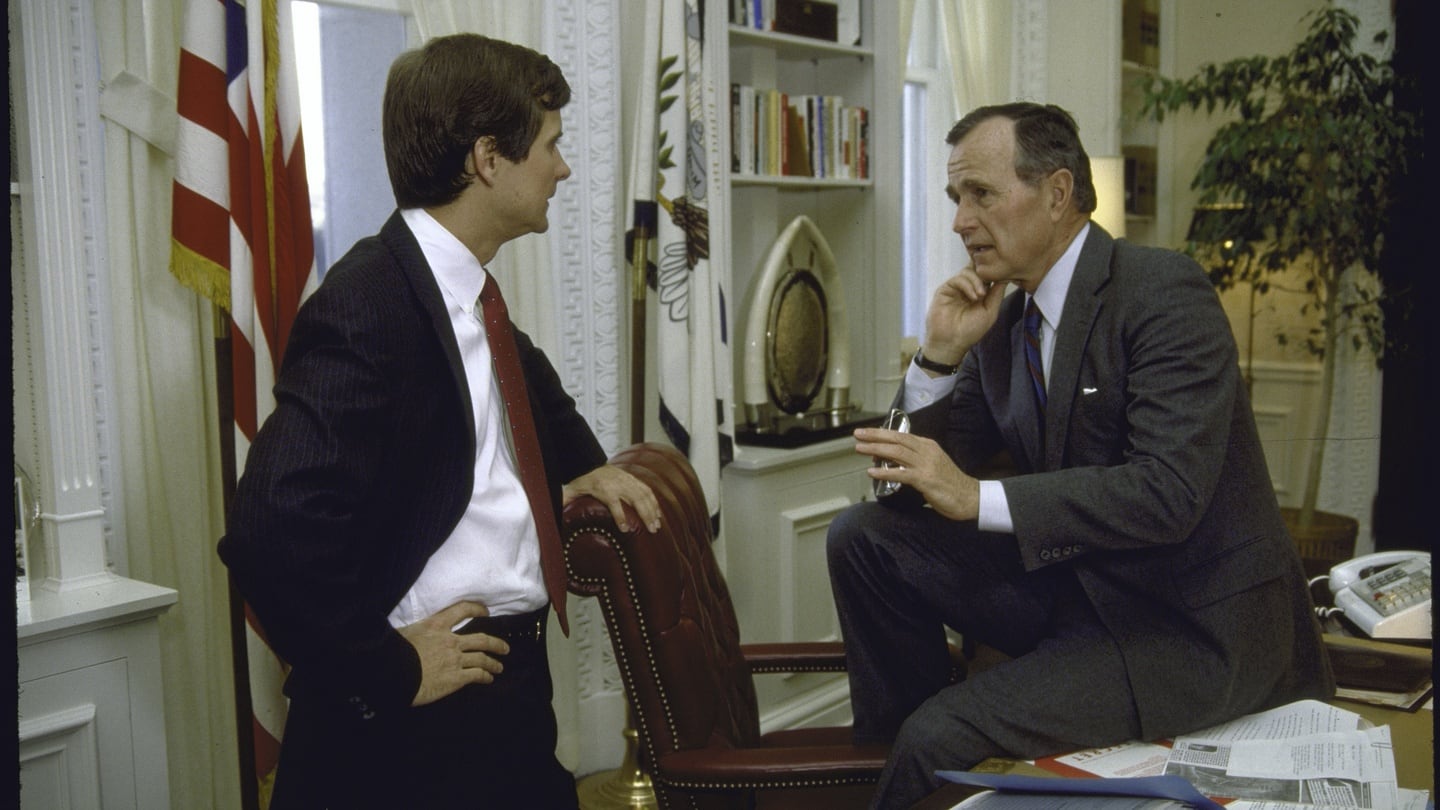In May 1988 George HW Bush's quest to become the first sitting United States vice-president in 150 years to win a presidential election was in trouble. His Democratic opponent, the Massachusetts governor Michael Dukakis, was 16 points ahead in the polls. Bush was being characterised as a lightweight and a lapdog of the outgoing Reagan presidency, which was mired in the Iran-contra scandal.
Bush's strategist, Lee Atwater, knew he had to change the dynamic. He handed his assistants a piece of card: "You get me the stuff to beat this little b*****d and put it on this card. Use both sides."
The card came back with a number of entries: Dukakis’s positions on defence; his record on tax and spending; the pollution of Boston Harbor; his position on the death penalty; his view on the pledge of allegiance; and his opposition to mandatory sentences for drug dealers.
0 of 3
The longest item on the card was Dukakis's position on prison furloughs, or temporary releases, including one case in which a murderer named Willie Horton had been released from a Massachusetts prison for a weekend, during which he had attacked and raped a woman in Maryland and stabbed her fiance.
Atwater declared that he would “strip the bark off the little b*****d” and “make Willie Horton his running mate”.
The use of the items on that card, and the mugshot of the African-American Horton, helped the Bush campaign to define Dukakis on their terms and go on to win the 1988 election comfortably.
Newsweek magazine summed it up by saying: "Anyone who felt good about American politics after the 1988 presidential campaign probably also enjoys train wrecks, or maybe a day at the beach watching an oil slick wash ashore."
A generation later the Bush-Dukakis contest is still regarded as the most successful example of negative campaigning in US political history. And “going negative” is seen as a sort of moral failure, particularly by the large part of the population that thinks “politics” and “politician” are dirty words.
In dramas such as The Good Wife or The West Wing idealistic candidates start off with the best intentions but ultimately are forced into negativity by the grinding logic of the political machine.
But is this really true? Anyone who has spent time in the US during an election campaign can tell you about the invective, half-truths and personal attacks that gush out of TV screens there.
A very Irish campaign
Here in
Ireland
it’s very different. So why do some people reach so quickly for the smelling salts at the first sign of anything “negative”?
This week the Fianna Fáil leader, Micheál Martin, unveiled the party's first billboard poster of the 2016 general-election campaign. To the surprise of some it featured a giant image of Enda Kenny, accompanied by the phrases: "I won't end the scandals of patients on trolleys. Tax cuts for the wealthiest come first." The Fine Gael logo in the bottom right-hand corner was twice the size of the text that bore Fianna Fáil's website address and the party's slogan: "There's a fairer way."
As some observers immediately pointed out, there was a good chance that, seen from a passing car, the poster might appear to be encouraging people to vote for the Taoiseach. After all, who reads all the words?
“Nobody in my party will indulge in personal attacks,” Kenny said loftily when asked for his view, undermining that slightly by going on to say that Fianna Fáil “fell flat like docile does in front of the troika”.
“Highlighting policy failures is a very fair and valid thing to do in a general election,” Martin responded. “It is not negative campaigning. It is a political message.”
It’s all part of the phoney war in advance of the election campaign proper, and we can expect more of the same as the parties jockey to set the agenda. But Martin is wrong on one point. The poster is negative, but what’s wrong with that?
Fundamentally, negative campaigning just means trying to win an electoral advantage by concentrating on your opponent’s negative attributes rather than your own positive ones. As such it’s a perfectly legitimate political tactic – in fact it’s hard to imagine any real political debate where drawing attention to the other side’s shortcomings didn’t form a large part of the process.
Dirty tricks
Where confusion may arise is that the phrase is also sometimes used to describe dirty-tricks operations, anonymous character assassination and the raking through of political opponents’ personal lives. There’s very little history of that in Irish politics, even when the opportunity seems to present itself.
A senior Labour Party strategist recalls that in the 2007 general-election campaign "there was a huge temptation to put Bertie Ahern's finances at the centre of the campaign. But there was caution because we knew how popular he still was."
Given that Ahern’s poll ratings had risen following his appearances before the Mahon tribunal, Labour ultimately decided against attacking him directly on the issue.
"I'm bemused at the faux outrage," says Martin Mackin, director of the public-relations company Q4 and a former Fianna Fáil general secretary, who says we have seen plenty of similar posters in past elections. "Politics isn't marquess-of-Queensberry stuff."
In fact the sort of sexual scandals that have played a significant part in US politics do not figure at all in Ireland, and personal attacks such as this week's on Kenny pale in comparison with the derision heaped on Ed Miliband, as leader of the British Labour Party, during last year's UK general election.
Alan Kinsella runs the website Irish Election Literature, a cornucopia of leaflets, posters, handouts and other printed material. Here you'll find all the ghosts of elections past: the badly conceived slogans, the unwise promises, the unflattering photographs, the appalling graphic designs.
Kinsella thinks Fianna Fáil’s poster will end up being of more benefit to Sinn Féin and other left-wing parties, but he points out that Ireland has not seen much negative campaigning, with one significant exception: parties moving away from political violence and towards parliamentary politics.
Fianna Fáil in the late 1920s and early 1930s was depicted as being under “the Shadow of the Gunman” in Cumann na nGaedheal posters; in turn Clann na Poblachta in 1948 was accused by Fianna Fáil of being pro-communist and anti-Catholic. Sinn Féin gets similar treatment today.
In none of these cases does much damage appear to have been inflicted on the respective parties.
For the most part, though, Irish elections are a lot more civil and less aggressive than, say, those in the UK. The Labour strategist puts that down to our electoral system.
“With first past the post you can be a little bit bolder,” he says. “But here there’s a caution about being too aggressive or attacking the other side.” With proportional representation there’s always the chance of a second or third preference if you haven’t alienated your rival’s supporters, he points out.
The most negative thing
“In an Irish election
the most negative thing you can do is tell people that your running mate’s seat is safe,” says Kinsella, referring to a recent controversy surrounding a Fine Gael candidate in Louth.
The Labour man was responsible for putting together the "draft" ad that leaked to the Sunday Independent two weeks ago showing Gerry Adams and Martin getting married – so highlighting the possibility of a Fianna Fail-Sinn Féin coalition – with various politicians from the left as the guests.
On that occasion it was Fianna Fáil’s turn to get sanctimonious about Labour daring “to offend the principle of marriage equality with a crude and stupid image”.
The ad also led to some hand-wringing within Labour. “We thought it was quite good because it was humorous,” says the Labour man unapologetically.
But that might be where the real pitfalls of negative campaigning lie. If you’re going to attack the other lot your execution has to be pitch perfect and you need to be 100 per cent sure you’ve left no hostages to fortune.
Martin repeatedly refused to make any commitment on hospital trolleys this week. “I had a look through the Fianna Fáil manifestos from 2002 and 2007,” says Kinsella, “and not once did they use the word ‘trolley’.” So the attack on Kenny was based on Fine Gael’s own previous election promises, and safety-proofed against blowback for Fianna Fáil. In the process the party may have lost sight of whether the poster was just confusing or ineffective.
Or maybe that doesn’t matter too much. Labour’s marriage ad will never be officially released or published, but it has still been seen by hundreds of thousands of people. Whether or not Fianna Fáil’s Kenny poster confuses passing motorists, it has already provided an image and a talking point for the party this week. It also puts Kenny’s face front and centre – something Fine Gael does not seem too keen on doing.
Social media
The dark arts of political messaging have been transformed by digital and social media. Why spend hundreds of thousands on billboards and newspaper ads if you can reach voters through
or
, especially if you can distance your party from some of the more aggressive tactics?
“The internet gives you a playground for plausible deniability,” says Mackin.
The most notable example of that came in the 2011 presidential election, when a tweet from a “nonofficial” Sinn Féin-supporting account was introduced into a live TV debate, with profound consequences for the leading candidate at the time, Seán Gallagher.
Twitter is home to thousands of party activists, particularly from the left. The phenomenon of “Shinnerbots”, Sinn Féin-supporting accounts that aggressively and personally attack party critics such as Senator Máiría Cahill, has been a feature for some years.
It remains to be seen whether Donald Trump's use of Instagram, Twitter and other social-media platforms to dominate the US primary debate with increasingly outrageous statements influences future developments here, but it seems unlikely in the short term. But social media allows new voices from left and right to bypass traditional media and speak to mass audiences in a more "authentic" and often more aggressive voice.
“In an unregulated medium like Twitter, which works for insurgents, there is more scope for exploitation,” says the Labour strategist. “Twitter is certainly important for us, because the media are on Twitter. But there are no floating voters on Twitter.”
For Labour, he says, Facebook, with its larger, less heavily politicised audiences, is the key, and it lends itself to less aggressive messages. The success of last year’s Yes Equality campaign, which refrained from attacking the motives or records of the opposing side, has also been noted.
The new danger for all the parties is that a single mis-step can be amplified and ridiculed and can go viral within hours. In that environment control, discipline and probably blandness are essential.
For the rest of January the political parties will be attempting to define the narrative of the forthcoming election, taking advantage of the narrow window before expenditure regulations kick in with the start of the campaign proper. As the campaign wears on we may see sharper attacks from parties losing ground.
“Criticism of the other side is something you hear in every political debate,” says the Labour strategist. “But it gets amplified in the heat of a general election.”
Does negative campaigning work? Only if it’s rooted in a real concern among the public. “You’re trying to tap into something that people may not like about your opponent.”
Mackin agrees. “If you get something that connects with the voters, then you can use that to reinforce your central message.”
















